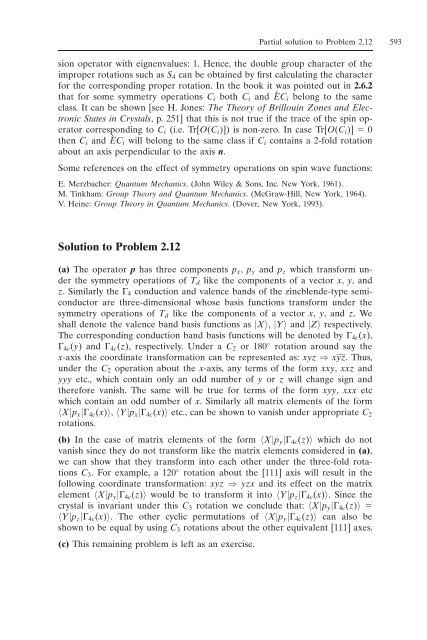10. Appendix
You also want an ePaper? Increase the reach of your titles
YUMPU automatically turns print PDFs into web optimized ePapers that Google loves.
Partial solution to Problem 2.12 593<br />
sion operator with eignenvalues: 1. Hence, the double group character of the<br />
improper rotations such as S4 can be obtained by first calculating the character<br />
for the corresponding proper rotation. In the book it was pointed out in 2.6.2<br />
that for some symmetry operations Ci both Ci and ÊCi belong to the same<br />
class. It can be shown [see H. Jones: The Theory of Brillouin Zones and Electronic<br />
States in Crystals, p. 251] that this is not true if the trace of the spin operator<br />
corresponding to Ci (i.e. Tr[O(Ci)]) is non-zero. In case Tr[O(Ci)] 0<br />
then Ci and ÊCi will belong to the same class if Ci contains a 2-fold rotation<br />
about an axis perpendicular to the axis n.<br />
Some references on the effect of symmetry operations on spin wave functions:<br />
E. Merzbacher: Quantum Mechanics. (John Wiley & Sons, Inc. New York, 1961).<br />
M. Tinkham: Group Theory and Quantum Mechanics. (McGraw-Hill, New York, 1964).<br />
V. Heine: Group Theory in Quantum Mechanics. (Dover, New York, 1993).<br />
Solution to Problem 2.12<br />
(a) The operator p has three components px, py and pz which transform under<br />
the symmetry operations of Td like the components of a vector x, y, and<br />
z. Similarly the °4 conduction and valence bands of the zincblende-type semiconductor<br />
are three-dimensional whose basis functions transform under the<br />
symmetry operations of Td like the components of a vector x, y, and z. We<br />
shall denote the valence band basis functions as |X〉, |Y〉 and |Z〉 respectively.<br />
The corresponding conduction band basis functions will be denoted by °4c(x),<br />
°4c(y) and °4c(z), respectively. Under a C2 or 180◦ rotation around say the<br />
x-axis the coordinate transformation can be represented as: xyz ⇒ xyz. Thus,<br />
under the C2 operation about the x-axis, any terms of the form xxy, xxz and<br />
yyy etc., which contain only an odd number of y or z will change sign and<br />
therefore vanish. The same will be true for terms of the form xyy, xxx etc<br />
which contain an odd number of x. Similarly all matrix elements of the form<br />
〈X|px|°4c(x)〉, 〈Y|px|°4c(x)〉 etc., can be shown to vanish under appropriate C2<br />
rotations.<br />
(b) In the case of matrix elements of the form 〈X|py|°4c(z)〉 which do not<br />
vanish since they do not transform like the matrix elements considered in (a),<br />
we can show that they transform into each other under the three-fold rotations<br />
C3. For example, a 120◦ rotation about the [111] axis will result in the<br />
following coordinate transformation: xyz ⇒ yzx and its effect on the matrix<br />
element 〈X|py|°4c(z)〉 would be to transform it into 〈Y|pz|°4c(x)〉. Since the<br />
crystal is invariant under this C3 rotation we conclude that: 〈X|py|°4c(z)〉 <br />
〈Y|pz|°4c(x)〉. The other cyclic permutations of 〈X|py|°4c(z)〉 can also be<br />
shown to be equal by using C3 rotations about the other equivalent [111] axes.<br />
(c) This remaining problem is left as an exercise.










